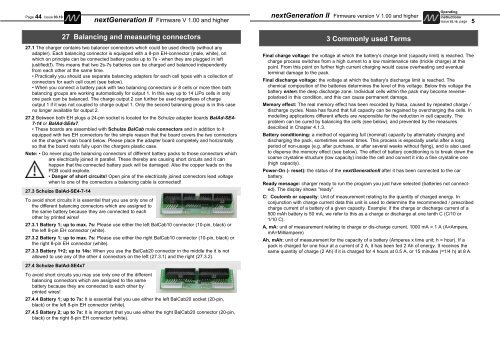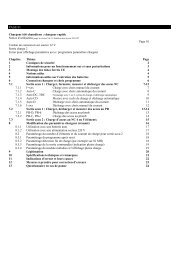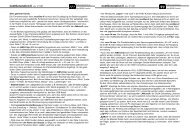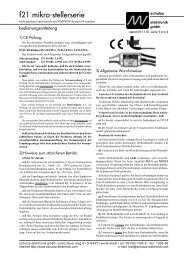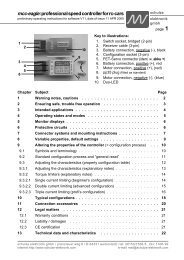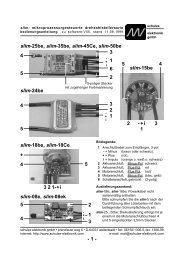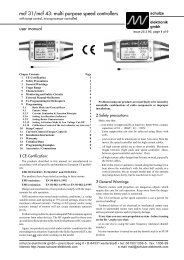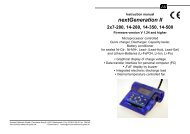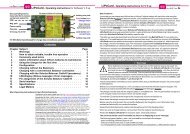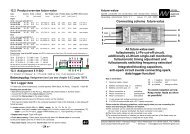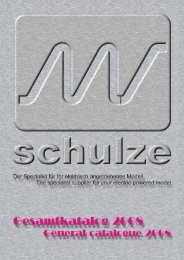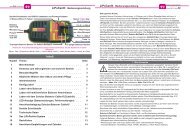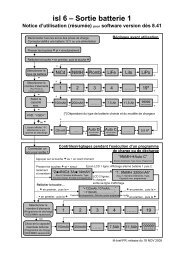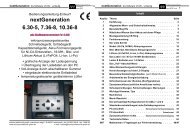nextGeneration II 2x7-280, 14-280, 14-350 - Schulze Elektronik GmbH
nextGeneration II 2x7-280, 14-280, 14-350 - Schulze Elektronik GmbH
nextGeneration II 2x7-280, 14-280, 14-350 - Schulze Elektronik GmbH
You also want an ePaper? Increase the reach of your titles
YUMPU automatically turns print PDFs into web optimized ePapers that Google loves.
44<br />
Page Issue 03.10<br />
Operating<br />
instructions<br />
Issue 03.10, page<br />
<strong>nextGeneration</strong> <strong>II</strong> Firmware version V 1.00 and higher<br />
<strong>nextGeneration</strong> <strong>II</strong> Firmware V 1.00 and higher 5<br />
27 Balancing and measuring connectors<br />
27.1 The charger contains two balancer connectors which could be used directly (without any<br />
adapter). Each balancing connector is equipped with a 8-pin EH-connector (male, white), on<br />
which on principle can be connected battery packs up to 7s - when they are plugged in left<br />
justified(!). This means that two 2s-7s batteries can be charged and balanced independently<br />
from each other at the same time.<br />
• Practically you should use separate balancing adapters for each cell types with a collection of<br />
connectors for each cell count (see below).<br />
• When you connect a battery pack with two balancing connectors or 8 cells or more then both<br />
balancing groups are working automatically for output 1. In this way up to <strong>14</strong> LiPo cells in only<br />
one pack can be balanced. The charge output 2 can further be used regardless of charge<br />
output 1 if it was not coupled to charge output 1. Only the second balancing group is in this case<br />
no longer available for output 2.<br />
27.2 Between both EH plugs a 24-pin socket is located for the <strong>Schulze</strong> adapter boards BalAd-SE4-<br />
7-<strong>14</strong> or BalAd-SE4x7.<br />
• These boards are assembled with <strong>Schulze</strong> BalCab male connectors and in addition to it<br />
equipped with two EH connectors for the simple reason that the board covers the two connectors<br />
on the charger's main board below. Please place the adapter board completely and horizontally<br />
so that the board rests fully upon the chargers plastic case.<br />
Note: • Do never plug the balancing connectors of different battery packs to those connectors which<br />
are electrically joined in parallel. These thereby are causing short circuits and it can<br />
happen that the connected battery pack will be damaged. Also the copper leads on the<br />
PCB could explode.<br />
• Danger of short circuits! Open pins of the electrically joined connectors lead voltage<br />
when to one of the connectors a balancing cable is connected!<br />
27.3 <strong>Schulze</strong> BalAd-SE4-7-<strong>14</strong><br />
To avoid short circuits it is essential that you use only one of<br />
the different balancing connectors which are assigned to<br />
the same battery because they are connected to each<br />
other by printed wires!<br />
27.3.1 Battery 1; up to max. 7s: Please use either the left BalCab10 connector (10-pin, black) or<br />
the left 8-pin EH connector (white).<br />
27.3.2 Battery 1; up to max. 7s: Please use either the right BalCab10 connector (10-pin, black) or<br />
the right 8-pin EH connector (white).<br />
27.3.3 Battery 1+2; up to <strong>14</strong>s: When you use the BalCab20 connector in the middle the it is not<br />
allowed to use any of the other 4 connectors on the left (27.3.1) and the right (27.3.2).<br />
27.4 <strong>Schulze</strong> BalAd-SE4x7<br />
To avoid short circuits you may use only one of the different<br />
balancing connectors which are assigned to the same<br />
battery because they are connected to each other by<br />
printed wires!<br />
27.4.4 Battery 1; up to 7s: It is essential that you use either the left BalCab20 socket (20-pin,<br />
black) or the left 8-pin EH connector (white).<br />
27.4.5 Battery 2; up to 7s: It is important that you use either the right BalCab20 connector (20-pin,<br />
black) or the right 8-pin EH connector (white).<br />
3 Commonly used Terms<br />
Final charge voltage: the voltage at which the battery's charge limit (capacity limit) is reached. The<br />
charge process switches from a high current to a low maintenance rate (trickle charge) at this<br />
point. From this point on further high current charging would cause overheating and eventual<br />
terminal damage to the pack.<br />
Final discharge voltage: the voltage at which the battery's discharge limit is reached. The<br />
chemical composition of the batteries determines the level of this voltage. Below this voltage the<br />
battery enters the deep discharge zone. Individual cells within the pack may become reversepolarised<br />
in this condition, and this can cause permanent damage.<br />
Memory effect: The real memory effect has been recorded by Nasa, caused by repeated charge /<br />
discharge cycles. Nasa has found that full capacity can be regained by overcharging the cells. In<br />
modelling applications different effects are responsible for the reduction in cell capacity. The<br />
problem can be cured by balancing the cells (see below), and prevented by the measures<br />
described in Chapter 4.1.3.<br />
Battery conditioning: a method of regaining full (nominal) capacity by alternately charging and<br />
discharging the pack, sometimes several times. This process is especially useful after a long<br />
period of non-usage (e.g. after purchase, or after several weeks without flying), and is also used<br />
to disperse the memory effect (see below). The effect of battery conditioning is to break down the<br />
coarse crystaline structure (low capacity) inside the cell and convert it into a fine crystaline one<br />
(high capacity).<br />
Power-On (- reset): the status of the <strong>nextGeneration</strong><strong>II</strong> after it has been connected to the car<br />
battery.<br />
Ready message: charger ready to run the program you just have selected (batteries not connected).<br />
The display shows "ready".<br />
C: Coulomb or capacity: Unit of measurement relating to the quantity of charged energy. In<br />
conjunction with charge current data this unit is used to determine the recommended / prescribed<br />
charge current of a battery of a given capacity. Example: if the charge or discharge current of a<br />
500 mAh battery is 50 mA, we refer to this as a charge or discharge at one tenth C (C/10 or<br />
1/10 C).<br />
A, mA: unit of measurement relating to charge or dis-charge current. 1000 mA = 1 A (A=Ampere,<br />
mA=Milliampere)<br />
Ah, mAh: unit of measurement for the capacity of a battery (Amperes x time unit; h = hour). If a<br />
pack is charged for one hour at a current of 2 A, it has been fed 2 Ah of energy. It receives the<br />
same quantity of charge (2 Ah) if it is charged for 4 hours at 0.5 A, or 15 minutes (=1/4 h) at 8 A.


